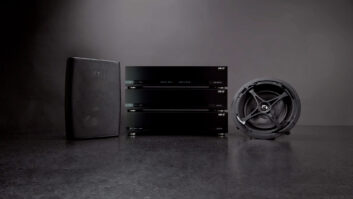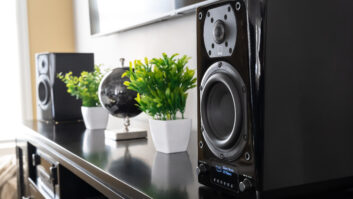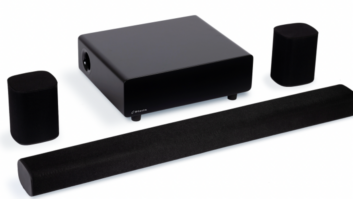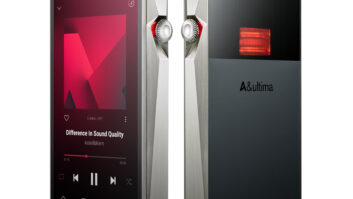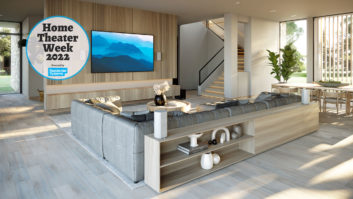A lot has changed in the audio landscape since I last reviewed Nuvo Technology’s Wireless Audio System back in 2013. First, the system has been rebranded the Player Portfolio series. Second, all three of the products sent for review are brand new, fleshing out the lineup to deliver a complete ecosystem. Third, with products like DTS’ Play-Fi, Bluesound, HEOS, and Riva Wand, Sonos is no longer the only competition in town.
[Reviewing Denon’s AVR-X6400H 11.2-channel AV receiver]
Nuvo (a Legrand brand) issued major revamps to the Player Portfolio series this year, launching several new products, including all those reviewed here. These include the P500 soundbar with wireless sub, the P4300 flagship version of its three-zone rack-mount solution, and the P400 all-in-one tabletop speaker solution. (Also launched was the P30, a 7-inch Android in-wall tablet controller, not reviewed here.)

These add to the existing P100 and P200 amplified players, P300 player pre-amplifier, and GW100 wireless gateway making for a complete offering that addresses the streaming audio needs in virtually every room.
Both the P400 and P500 communicate via wired or Wi-Fi 802.11a/b/g/n, while the P4300 requires a hardwired Ethernet connection to the network. As the P4300 is intended for rack mounting (ears included), this shouldn’t pose an issue. The P4300 includes an internal switch to feed all three players with a single connection.

As a single room, fully inclusive system, the P400 requires nothing beyond power. Connection-wise it includes USB and mini-jack input that accepts analog or Toslink. The P500 offers both an analog and Toslink digital audio input for connecting the TV’s audio as well as a USB. The P4300 offers the most connections, with speaker connections for each zone (impedance selectable between 4/6/8 ohms), three sets of mini-jack inputs and outputs (selectable fixed or variable) that accept RCA analog or Toslink optical (adapters included), three trigger outputs, and three USB inputs. Other than the optical input on the soundbar, any input on any player is available for listening on any other player. (Nuvo said there is a latency issue between audio and video when streaming, and may make the P500’s optical input available later.)
[Legrand grows sales and product teams with two promotions]
Installation begins by installing the Nuvo Player app on either an iOS or Android device. Before you can connect the P400 or P500 wirelessly, you must first connect to the network via an Ethernet cable. (This hardwired step isn’t required if using Nuvo’s GW100 gateway.) Once activated, you select from 28 different icons to identify the room, and then name that zone. After a firmware update on each player, I was ready to go. From start to finish (not counting unboxing or wall mounting the P500 soundbar) the whole process took maybe 10 minutes.
Once all players are added, it’s easy to tweak the audio settings in each zone. The key word here is “easy,” as this is something the homeowner can do without engaging you. Beyond bass, treble, and balance, you can set turn-on volume, maximum volume, brightness levels, and more. I loved that the P4300 gives the option to turn a zone into mono, perfect for areas where speakers are widely separated like hallways or outdoor speakers.
On the streaming front, Player Portfolio supports iHeartRadio, Pandora, Spotify Connect, TuneIn, Deezer, Napster, and SiriusXM natively. You can also play any music stored on your iOS or Android device. While the P200 supports Bluetooth streaming, none of these players do. Nuvo’s free-to-download Music Share software is required for adding stored music libraries. I pointed it to my Western Digital NAS drive, scanned it in, and had access to my near-10,000-song library. And, yes, the system supports Hi-Res audio files up to 192kHz/24-bit.
I started listening to the P500 bar, watching a variety of TV and movie content. As this is only a 2.1-channel bar, don’t expect much in the way of surround sound. The bar delivers a bit in the way of width and height, but really shines on dialog reproduction. I never had any trouble understanding anything, which is one of the biggest solutions soundbars address. There are four different EQ modes: Music, Movie, Vocal, and Night, but I didn’t notice much difference from any of them, short of Night noticeably compressing the audio, taking out the highs and lows for more uniform listening, and Movie seeming boomier on the low end.

Blending the sub’s bass output with the bar was a bit trickier than normal. I ended up setting the sub’s volume between -4 and -5, which helped reduce the chestiness of male vocals, and retained just enough tactile bass that I could still occasionally feel it in my bed. It’d nice if there were a way to save bass levels independently for both Music and Movie EQ settings, and have the system automatically pick Music mode when it flipped into streaming.
I sat the P400 on the counter in our kitchen, angled in a corner. It is not a small speaker, which is good for delivering rich, full-range sound, but maybe less so for counter or desktop use. I thought the P400 sounded great, playing quite loud and producing punchy, deep bass. It couldn’t quite hit the lowest octave of the The Crystal Method’s “High Roller,” but it got admirably close. For listening while cooking or mingling in the kitchen, it did a great job.
The P4300 includes “110 watts per zone,” which I take to mean 55 watts x six channels. While the P4300 couldn’t match the Meridian 258’s dynamics and punch (review available online), it was beyond capable of driving the variety of speakers I connected to it, including 6.5-inch in-ceilings, 6.5-inch surface mounts, and 10-inch in-ceilings. I used it to drive my bathroom speakers every morning without hiccup or complaint.
I appreciated how the user experience was identically simple whether using the P500, P400, or P4300. The well-designed app is intuitive to start music playing in any single zone, or join zones together for synched listening. Just tap a room to get it playing, or drag it into another zone to join them. The new zone(s) join and start playing the same music in perfect sync, and volume can be adjusted individually or all at once. Unlinking zones is as simple as dragging them out of the group. I also loved how the iPad app made full use of the larger real estate, using three panes to display all zones, playing options, and now playing/up next queue.
I used both the iPhone and iPad versions of the app and Nuvo did a great job creating something that is equal parts powerful, intuitive, slick, and easy to use. Beyond the Nuvo app, integrators will appreciate third-party integration support for Vantage, Crestron, Control4, KNX, RTI, and URC. I added the Nuvo to my Control4 system and it worked like a champ. The system also supports Domotz PRO’s remote monitoring.
With these new products and numerous other developments over the past four years, Nuvo has made the Player Portfolio series even more compelling. Factor in terrific support for the CI channel, tight control over distribution, and solid dealer margins, and it all adds up to lots to get excited about!

